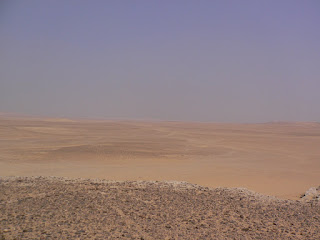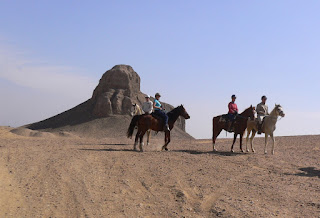
Trailriding as done in most places involves trails that have beginnings and endings and sides that define what is "on the trail" as well as what is "off the trail". Egypt has trails like that in the farming areas. They usually wind along canals and next to fields. They vary from about 10 cm in width to decent dirt roads for cars depending on what kind of traffic uses them...donkeys, carts, horsewagons, or pickups.

These trails are great fun for riding, especially in the summer when the sun hitting the sand in the desert reflects back up at you like a blast furnace. The valley dirt is darker and absorbs the sunlight, while the trees offer shade and the canals give up moisture to soften the heat. The downside of riding trails in Egypt is that you can't really predict what you are going to meet. Perhaps the trail will have a small valley across it filled with runoff from a field next to it being irrigated. Initially a 10 cm ditch filled with running water might as well be the Grand Canyon for most horses. With practice they learn to jump the ditches or even (will wonders never cease?) step over them.
 There are also extremely threatening objects and creatures to be passed. A diesel water pump racketing away next to the canal and jetting forth a column of water almost 10 cm across and extending out for a metre and a half is definitely a reason for most horses to stop and goggle for a bit. Fortunately, most times the water column is not directed across the trail but along it and into a concrete well to flow under the trail in a pipe. When the water is blocking the trail, the farmers are generally willing to turn off the pump for couple of moments so that they horses can pass...though convincing novice mounts to walk through mud and water and next to the previously noisy monster can be lots of fun.
There are also extremely threatening objects and creatures to be passed. A diesel water pump racketing away next to the canal and jetting forth a column of water almost 10 cm across and extending out for a metre and a half is definitely a reason for most horses to stop and goggle for a bit. Fortunately, most times the water column is not directed across the trail but along it and into a concrete well to flow under the trail in a pipe. When the water is blocking the trail, the farmers are generally willing to turn off the pump for couple of moments so that they horses can pass...though convincing novice mounts to walk through mud and water and next to the previously noisy monster can be lots of fun.
With all of these hazards to deal with in the farming areas, it really is not surprising that most riders prefer to go riding out in the desert. Our desert is most convenient in that there is nothing at all to spook the horses. There are no trees, no buildings, no human activity, no roads. Even the wild dogs and the foxes tend to avoid riders so there you are in the world's largest arena all by yourself. But this brings up a new issue. How do you navigate? Sailors out in the trackless oceans must take note of the stars to determine where they are, so what do riders in the Sahara do? Well, obviously...we navigate by pyramids.

So we venture out into the sands from the valley, and if as sometimes is the case early on a winter morning, there is fog, we can be in big trouble. The desert in this area can occasionally be foggy enough to hide even a pyramid, and I once found myself at a ruined house on a plateau a kilometre from the watchman's shack next to the pyramids of Abu Sir that I'd been aiming for.
 Assuming that it isn't that foggy, the first landmarks are the pyramids of Abu Sir, which are visible quite clearly from the valley.
Assuming that it isn't that foggy, the first landmarks are the pyramids of Abu Sir, which are visible quite clearly from the valley. Once past the pyramids, the desert spreads before you and the next good landmark is an outcropping of the plateau known as the Japanese Hill.
 It acquired this name due to the fact that the Japanese have been coming here every July for about the past twenty years to excavate a temple near the base of the hill and what seems to be a lookout post on the top. From the top of the hill you get the best view of the desert available. To the north can be seen the the three huge pyramids at Giza, if the haze isn't too thick. Just below lie the pyramids of Abu Sir and its Sun Temple just north of the pyramids. Southwest can be seen the Step Pyramid at Sakkara and the many other mostly ruined pyramids stretching south along the valley with its seagreen palm groves. Finally to the south, lie the pyramids at Dahshur, the Red Pyramid, the Bent Pyramid, and off next to the lake, the Black Pyramid.
It acquired this name due to the fact that the Japanese have been coming here every July for about the past twenty years to excavate a temple near the base of the hill and what seems to be a lookout post on the top. From the top of the hill you get the best view of the desert available. To the north can be seen the the three huge pyramids at Giza, if the haze isn't too thick. Just below lie the pyramids of Abu Sir and its Sun Temple just north of the pyramids. Southwest can be seen the Step Pyramid at Sakkara and the many other mostly ruined pyramids stretching south along the valley with its seagreen palm groves. Finally to the south, lie the pyramids at Dahshur, the Red Pyramid, the Bent Pyramid, and off next to the lake, the Black Pyramid.
As we make our way down the hill, the Step Pyramid is our first landmark, to be kept to the left. With so many archaeological teams digging in Sakkara, the Antiquities Council is a bit nervous when riders wander too close to the area, so we stay about half a kilometre in from the excavation areas. The desert isn't flat so from time to time we find ourselves in a hollow area from which we can't see any pyramids, so the best thing to do is to make our way to high ground from which we can again get our bearings.

Just south of the Step Pyramid there is just such a rise, from which Mastabat Pharaon (the Pharoah's Mastaba or bench), a birthday cake-looking structure can be seen to the south past a couple of wadis. Next to it is the pyramid of one of the Pepi's, of which there are quite a few at Sakkara. To the right and about five kilometres on can be seen the Red Pyramid at Dahshur with the Bent Pyramid in the haze behind it. Because everything is more or less the same colour and there are no normal sized objects to use for reference, it's very difficult to judge distance, and hills just sort of blend into each other, hiding the wadis. Between Mastabat Pharaon and the Red Pyramid, for example, lies a wadi (valley), some hills, a railway track that leads to Fayoum with our favourite sarcophagus, more excavations, a natural gas pumping station, an asphalt road and quite a lot of desert.
 None of this is obvious from the view by the Step Pyramid, so we take a sight on the Mastaba and then aim for a spot left of the Red Pyramid to find the sarcophagus marking the crossing point on the railway tracks. The next section of the trip is a bit difficult because there is a fence that runs across the route we want to take to the Red Pyramid. I'm not sure who built it, the army, the gas company, the Antiquities Council?...but almost immediately upon it being built someone had very effectively cut a couple of holes in it sufficient to drive a jeep or ride a horse or camel through. Egyptians don't really like fences. With practice, finding the hole is not that difficult...it's the only section of fence without a layer of plastic bags stuck to it...and we make our way into the Dahshur section of the ride.
None of this is obvious from the view by the Step Pyramid, so we take a sight on the Mastaba and then aim for a spot left of the Red Pyramid to find the sarcophagus marking the crossing point on the railway tracks. The next section of the trip is a bit difficult because there is a fence that runs across the route we want to take to the Red Pyramid. I'm not sure who built it, the army, the gas company, the Antiquities Council?...but almost immediately upon it being built someone had very effectively cut a couple of holes in it sufficient to drive a jeep or ride a horse or camel through. Egyptians don't really like fences. With practice, finding the hole is not that difficult...it's the only section of fence without a layer of plastic bags stuck to it...and we make our way into the Dahshur section of the ride.  Because the Antiquities Council takes a dim view of people entering its sites without a ticket, and because the entry office won't sell tickets to people on horseback, we usually give the Red and Bent Pyramids a miss, admiring them from afar, and head to the Black Pyramid next to the lake.
Because the Antiquities Council takes a dim view of people entering its sites without a ticket, and because the entry office won't sell tickets to people on horseback, we usually give the Red and Bent Pyramids a miss, admiring them from afar, and head to the Black Pyramid next to the lake.
This pyramid was built of millions of mud bricks, about half of which survive today. It doesn't look much like a pyramid, actually, more like an upended, half melted ice cream cone, one of the old kind with the flat bottoms. As we approach from the desert, the pyramid's bulk hides the lake bed behind it, but as we move around it the green of the lake bed comes into view and the horses are pleased. There's usually a rest stop by the lake, a drink, a snack and then one of those nice things that come in handy every so often....a trail through the palm groves to take you home.
copyright 2007 Maryanne Stroud Gabbani





